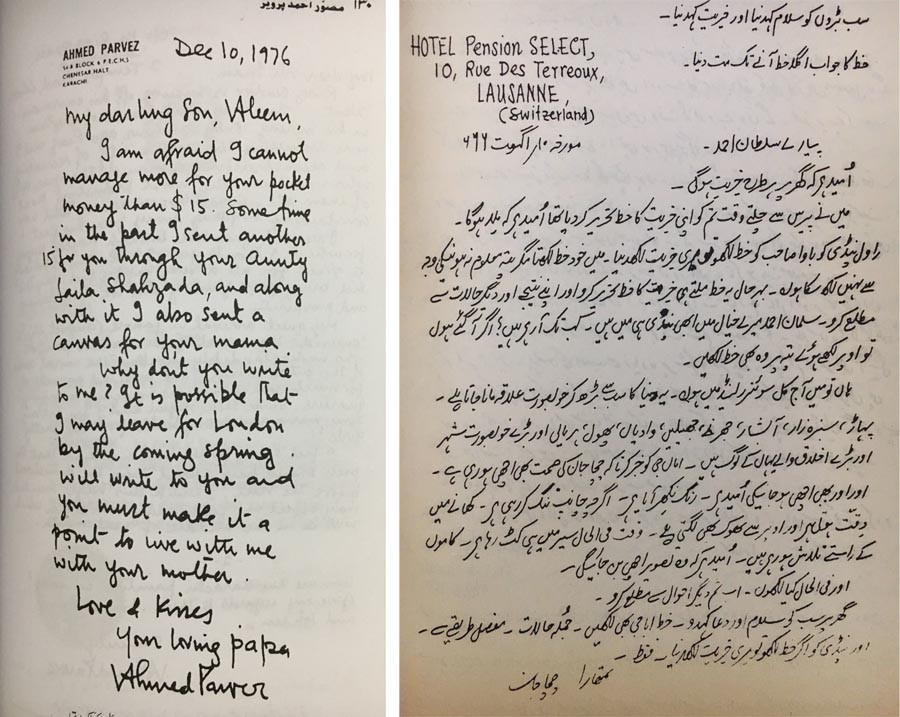

Zahoor ul Akhlaq once wrote a letter from Canada to his friend and collector in Karachi. The letter began with the name of addressee, greetings and then the first line that read "The situation is like this". The rest of the page was blank, ending with his signature. White space conveyed what the artist had presumably intended. Akhlaq’s work reflects a selective and sophisticated approach. The surfaces are not loaded with images and marks or filled with colours. Most of his paintings are rendered with a pictorial subtlety, for instance the incredible triptych of three riders, a variation on the Mughal miniature depicting Shahjahan’s three princes on horses.
One wonders about the relevance of an artist’s letter to his artwork. Both are creations as well as means of communication; though each rely on a different diction -- words or visuals. However, it is also true that many works of art are text-based while some letters are mainly composed of pictures and signs.
The critical difference lies in the nature of these two expressions, being either public or private. Artwork, even though produced in the intimacy of an artist’s studio, is meant for sharing with a larger population while letters are addressed to and accessed by one individual.
A recent book Pen to Paper examines and presents artists’ handwritten letters. Published in 2016 by Princeton Archival Press, New York, the book contains facsimiles of letters by 56 artists, including figures such as Jackson Pollock, Marcel Duchamp, Dan Flavin, Robert Motherwell, Isamu Noguchi, Georgia O’Keeffe, Alexander Calder, Ad Reinhardt, William de Kooning. The letters, in the words of Arthur C. Danto on earlier works of famous artists "have as interest only the fact that someone who became great doing something else executed them".
If these letters were not written by celebrated names of modern and contemporary art, they would just be scraps of paper, not worthy of a second glance. These letters can be ‘read’ in two ways. For their pictorial appeal, like Roberto Matta’s letter to Joseph Cornell appears a work of art due to the colours added into alphabets, its shift of scale, or the composition of script or letters of Philip Guston and Oscar Bluemner with drawings in the text.
On the other hand the content, if deciphered, contributes in understanding an artist’s concepts/concerns, and is instrumental in shaping the course of art. Remember the famous quote of Paul Cezanne, from his letter to Emile Bernard, "treat nature by the cylinder, the sphere, the cone, everything in proper perspective so that each side of an object or a plane is directed towards a central point". Lines jotted down at his house in Aix-en-Provence for his fellow artist and follower became pivotal points/principles in evolving Cubism.
Letters are important, because the artists or fiction writers are free to comment on something they don’t openly do. In her letter to Jackson Pollock, Lee Krasner after visiting Left Bank galleries and Louvre in Paris comments, "the painting here is unbelievably bad". Or Joan Sloan in his letter to Mary Fanton Roberts sarcastically remarks on the way his painting was hung too high, "Did your foresight prompt you to tour the show with a ladder?"
By and large these letters, coming out of the ghetto of the personal, are now in the realm of public -- to examine the way an artist thinks and puts pen on paper. A drawing, painting, print, or carving also embodies the ‘handwriting’ of an artist. According to E. H. Gombrich, Van Gogh (a painter with a large body of letters to his brother) emphasised the aspect of an artist’s signature through his brush strokes, "…he painted as other men write. Just as the appearance of a handwritten page, the traces left by the pen on paper, impart something of the gesture of the writer".
In one of his letters from Arles, Van Gogh describes his inner self: "the emotions are sometimes so strong that one works without being aware of working…. and the strokes come with a sequence and coherence like words in a speech or a letter". While knowing his work, one realises that it is not only what an artist paints, draws or carves, but how he does it.
There are a few artists who incorporate this element - of handwriting - in their art, namely Cy Twombly, with scribbling, scrawling, doodling, instead of conventional ‘picture making’. The artist is in a way writing huge letters -- in paint on canvas -- to viewers.
No one in Pakistan attempted that, but one comes across several letters of Sadequain and Ahmed Parvez (reproduced in different books). Some deal with mundane matters, others address issues of aesthetics. Sadequain’s letters open new dimension to know the artist. Addressed mostly to his family, he recounts his experience in France. These texts - inscribed in elegant handwriting of the painter who later was also recognised as a calligraphy artist -- reveal a young artist’s time (1964) in a distant city who talks about Albert Camus and other writers to his nephew living in Karachi.
In recent times, perhaps the only major letter writer among artists is Iqbal Geoffrey. He regularly dispatches pages, often photocopies, with markings, clippings and notes which make them unique objects. I once received in an envelope a folded paper, a print with writings and painted portions by Geoffrey, a letter yes but also a superb sample of his art (hanging on a wall in my house).
In the age of Internet, how long will we have that hand that writes messages? Now, you only receive letters on your screens and respond by typing. This negates the personal touch. Similarly, in future, a work of art will not be made with a tool such as brush, chisel, pencil, hammer; it will be a computerised image, displayed not in a gallery but on Facebook, Instagram, WhatsApp, Pinterest. That future perhaps has already arrived.